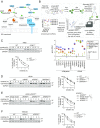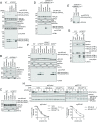Ribosomal protein RPL26 is the principal target of UFMylation
- PMID: 30626644
- PMCID: PMC6347690
- DOI: 10.1073/pnas.1816202116
Ribosomal protein RPL26 is the principal target of UFMylation
Abstract
Ubiquitin fold modifier 1 (UFM1) is a small, metazoan-specific, ubiquitin-like protein modifier that is essential for embryonic development. Although loss-of-function mutations in UFM1 conjugation are linked to endoplasmic reticulum (ER) stress, neither the biological function nor the relevant cellular targets of this protein modifier are known. Here, we show that a largely uncharacterized ribosomal protein, RPL26, is the principal target of UFM1 conjugation. RPL26 UFMylation and de-UFMylation is catalyzed by enzyme complexes tethered to the cytoplasmic surface of the ER and UFMylated RPL26 is highly enriched on ER membrane-bound ribosomes and polysomes. Biochemical analysis and structural modeling establish that UFMylated RPL26 and the UFMylation machinery are in close proximity to the SEC61 translocon, suggesting that this modification plays a direct role in cotranslational protein translocation into the ER. These data suggest that UFMylation is a ribosomal modification specialized to facilitate metazoan-specific protein biogenesis at the ER.
Keywords: RPL26; UFM1; UFMylation; endoplasmic reticulum.
Conflict of interest statement
The authors declare no conflict of interest.
Figures





References
-
- Cai Y, Singh N, Li H. Essential role of Ufm1 conjugation in the hematopoietic system. Exp Hematol. 2016;44:442–446. - PubMed
Publication types
MeSH terms
Substances
Grants and funding
LinkOut - more resources
Full Text Sources
Other Literature Sources
Molecular Biology Databases
Research Materials

